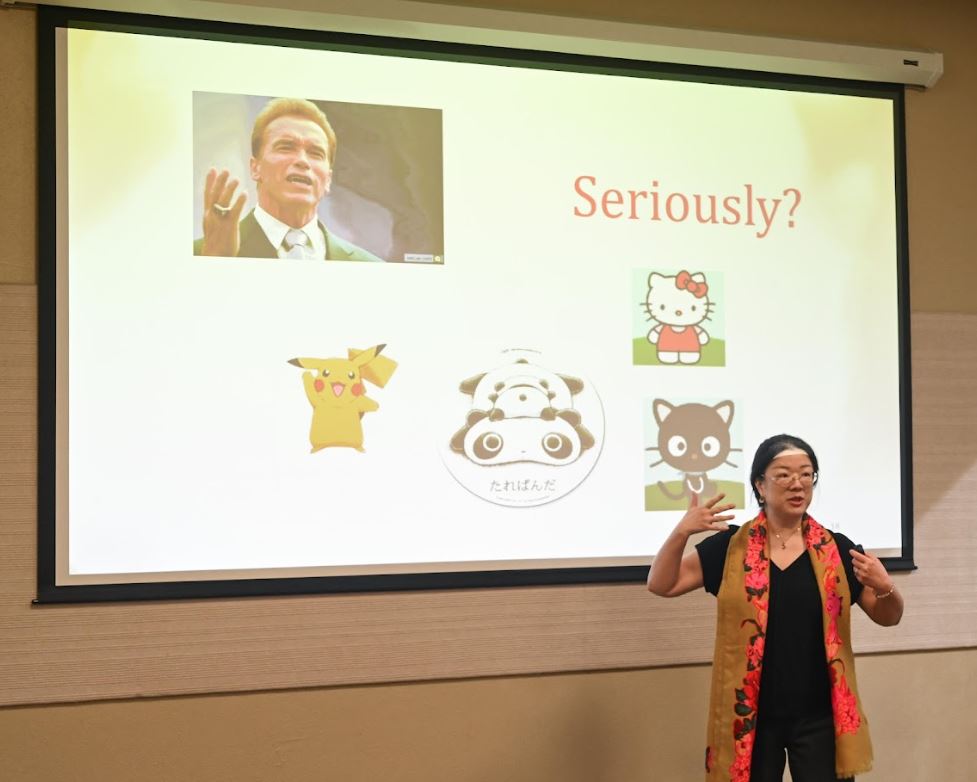Story by ADIA REYNOLDS Photos by RORY MOORE
Tiger Media Network
Times Talk is a monthly on-campus event run by the American Democracy Project. Tuesday’s installment marked the discussion of “Cute Politics!: Articulating the Kawaii Aesthetic, Fandom, and Political Participation” by FHSU Professor of Communication Studies Hsin-Yen Yang. Situated in the upper level of the Memorial Union, students and faculty were treated to complimentary stickers, pins, and food before the lecture began. The stickers were themed to the event, with characters that fit the aesthetic tabled for discussion.
“My favorite is Choco-Cat,” Yang began with a strong component of relatability. Most people in attendance were familiar with kawaii aesthetics, even if they didn’t know it by name.
One of Yang’s students, Harley Headley, was able to recognize the aesthetic from online videos.
“I knew about kawaii aesthetics via animation and YouTubers I used to watch. All cute and kind aesthetic… I had no clue that this culture and style also showed in the politics of Asia,” Headley said. “I thought it was just a style preference.”
Though it began with girls’ stylistic handwriting in Japan, kawaii aesthetics was corporatized by Sanrio into the recognizable characters that are beloved all across the globe today. Characters like Hello Kitty and the aforementioned Choco-Cat.
“Not everything cute is kawaii, Yang said.
She went on to explain that kawaii is steeped in various Asian cultures. It is a Japanese term that combines two Chinese characters, 可 and 愛. So kawaii, or 可愛, almost directly translates to ‘lovable.’ The aesthetic itself is characterized by a disproportionately big head, a small round body, big eyes, and an innocent look.
Yang has been studying the impact of the kawaii aesthetic since the year 2000.
“I was interested in how culture, especially pop culture, was an integral part of politics,” Yang said.
Malaysia, Taiwan, Japan, and South Korea are all countries that engage with Kawaii Politics. Police stations in Japan and South Korea have cute mascots, which, according to Yang’s presentation, is a form of ‘authority cuteness.’ Authority cuteness describes the ways in which the powerful institutions in society try to soften their images and messages to gain public support.
As a more hands-on example, Yang had the attendees pass around dolls produced by the DPP political party of Taiwan. These were real-life examples of the way cute culture has shaped political outreach and public relations in candidates’ campaigns.
“The action of buying those [the dolls] is a demonstration of political support and a donation to that party,” Yang said.
The purchasing power of consumers ties directly into campaign donations in this way. People can express both social membership and political ownership through their consumerism.
“The powerlessness of cuteness itself is the very source of its power,” Yang said. “Fans use pop culture as a resource or springboard for civic engagement and political actions… the binary positioning of fans and citizens is not justifiable because it assumes most fans are political eunuchs.”
When discussing how this aesthetic might go over in a western culture such as the United States, Yang said western political systems might be a bit more questioning of its validity.
Assistant Professor of Philosophy David Tostenson was in attendance and agreed.
“It’s hard to see something like that going over well in this country,” he said.
Another attendee, Perla Zamorano, offered a slight dissent.
“Political campaigns in the U.S. have started trying to reach young people through social media,” Zamorano said.
This shift in strategy can also be seen in the tactics of the American Democracy Project. The ADP on-campus has offered “Voting isn’t Scary!” pins and tote bags for the month of October that include graphics of cute ghosts in order to encourage and remind students of their civic duties. Though neither of these are kawaii by any measure, they offer notable examples of how American politics are shifting to meet the interests of younger demographics and consumers.
“Minor aesthetics deserve the same level of serious attention that academics have given to the grand, the beautiful, and the sublime,” Yang said.









